2D RF spoiled gradient echo sequence, TR = 12 ms, TE = 6 ms, FA = 60°
Dependence on the number of subvoxels in the readout direction
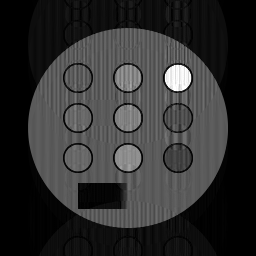

subvoxel = 1×1×4 (11.223 s) subvoxel = 2×1×4 (21.944 s)
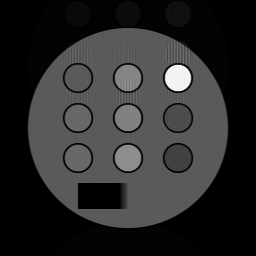
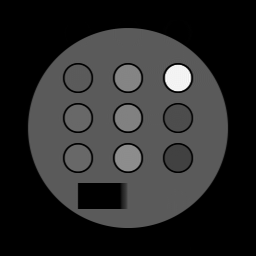
subvoxel = 4×1×4 (43.421 s) subvoxel = 8×1×4 (88.215 s)
The numbers in red show the calculation time using the RTX 2080Ti.
The total number of subvoxels are 13,572,096, 27,335,680, 54,863,872, and 109,920,256.
Pulse sequence visualized by the SequenceViewer:
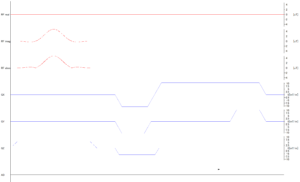
One data-acquisition sequence (TR = 12 ms). The amplitude of the phase encoding gradient (Gy) is maximum (-).
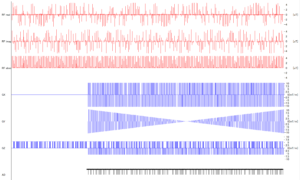
Entire pulse sequence. The first 100 TRs are the dummy sequences to establish the steady state. The next 256 TRs are the data-acquisition sequence. The RF pulses have phase (θ) variation for the RF spoiling: RF phase θ = n(n+1)/2 * φ (φ = 117º).
Python sequence code:
from psdk import *
import numpy as np
gamma = 42.57747892 # [MHz/T]
TR = 12.0e+3 # [us]
TE = 6.0e+3 # [us]
NR = 256 # Number of readout points
NPE1 = 256 # Number of 1st phase encoding
fov = [220.0, 220.0, 256.0] # [mm]
dwell_time = 10.0 # [us]
slice_width = 5.0 # [mm]
gx_value = 1e+6 / (dwell_time * gamma * fov[0]) # [mT/m]
gy_value = 2e+6 / (dwell_time * gamma * fov[1]) * NPE1 / NR # [mT/m]
gz_value = 1.25 / (slice_width * 1.0e-3) / gamma # [mT/m]
gx_rt = 300.0 # [us] gx rise time
gy_rt = 300.0 # [us] gy rise time
gz_rt = 300.0 # [us] gz rise time
ex_pulse_width = 3200.0 # [us]
ex_pulse_flip_angle = 60.0 # [degree]
def phase_shift_angle(i):
phi = i * (i + 1) / 2 * 117 / 360
phi -= round(phi)
return 2.0 * np.pi * phi
def sinc_with_hamming(flip_angle, pulse_width, points, *, min = -2.0 * np.pi, max = 2.0 * np.pi):
x0 = np.arange(min, max, (max - min) / points)
x1 = x0 + (max - min) / points
y = (np.sinc(x0 / np.pi) + np.sinc(x1 / np.pi)) * 0.5 * np.hamming(points)
return flip_angle * y * points / (y.sum() * pulse_width * 360.0e-6 * gamma)
with Sequence('2D Spoiled GRE'):
with Block('Dummy', ex_pulse_width + 2.0*gz_rt):
GZ(0.0, gz_value, gz_rt)
RF(gz_rt, sinc_with_hamming(ex_pulse_flip_angle, ex_pulse_width, 160), ex_pulse_width / 160,
phase=([phase_shift_angle(i) for i in range(100)], ['Dummy']))
GZ(ex_pulse_width + gz_rt, 0.0, gz_rt)
with Block('Excitation', ex_pulse_width + 2.0*gz_rt):
GZ(0.0, gz_value, gz_rt)
RF(gz_rt, sinc_with_hamming(ex_pulse_flip_angle, ex_pulse_width, 160), ex_pulse_width / 160,
phase=([phase_shift_angle(i+100) for i in range(NPE1)], ['PE1']))
GZ(ex_pulse_width + gz_rt, 0.0, gz_rt)
with Block('PhaseEncoding', NR // 2 * dwell_time + gx_rt * 2.5):
GX(0.0, -gx_value, gx_rt)
GY(0.0, ([gy_value * (i - NPE1 // 2) / NPE1 for i in range(NPE1)], ['PE1']), gy_rt)
GY(NR // 2 * dwell_time, 0.0, gy_rt)
GX(NR // 2 * dwell_time + gx_rt * 0.5, gx_value, gx_rt * 2.0)
GZ(0.0, -gz_value, gz_rt * 0.6)
GZ(ex_pulse_width * 0.5 + 150, 0.0, gz_rt * 0.6)
with Block('Readout', NR * dwell_time):
AD(0.0, NR, dwell_time, phase=([phase_shift_angle(i+100) for i in range(NPE1)], ['PE1']))
with Block('Rewinding', NR // 2 * dwell_time + gx_rt * 2.5):
GY(gx_rt * 2.5 - gy_rt, ([gy_value * (NPE1 // 2 - i) / NPE1 for i in range(NPE1)], ['PE1']), gy_rt)
GX(NR // 2 * dwell_time + gx_rt * 2.5 - gx_rt, 0.0, gx_rt)
GY(NR // 2 * dwell_time + gx_rt * 2.5 - gy_rt, 0.0, gy_rt)
with Main():
with Loop('Dummy', 100):
BlockRef('Dummy')
WaitUntil(TR)
with Loop('PE1', NPE1):
BlockRef('Excitation')
WaitUntil(TE + ex_pulse_width * 0.5 + gz_rt - NR // 2 * 2 * dwell_time - gx_rt * 2.5)
BlockRef('PhaseEncoding')
BlockRef('Readout')
BlockRef('Rewinding')
WaitUntil(TR)
